Humperdinck: Hansel and Gretel
Introduction
Engelbert Humberdinck is remembered chiefly for two things. He was a pupil of Wagner, and he wrote this opera. I'm sure there were many 'one hit wonders' before him, but Humperdinck must surely take the crown, in that most people only know his name because it was used by a glorified lounge singer almost 50 years after he died.
The first performance of this work was given in Weimar in December 1893, and conducted by Richard Strauss, who proclaimed it to be one of the best things since sliced childre..bread (although if you believe some internet sites, it was Mahler who conducted the first performance, in September the following year, and in Hamburg).
The original tale from the 'Brothers Grimm' is one of parental cruelty and almost unimaginable horror - much like a Daily Mail/Express editorial on 'Broken Britain', should there be a dearth of Diana stories around at the time. Humperdinck's take on the story lightens things up somewhat, in that the parents don't actually try to lose their children (at least twice) in the forest, but they are sent off to gather various types of berries after playing around too much and getting on their mother's nerves. The family is hungry after all, and the jug of spilt cream which was the result of a little too much horse-play tipped mum over the edge.
Father, a broom-maker by trade, turns up tired and emotional, and is shocked to find his wife has allowed the kids out. He warns her of the evil witch that lives within the heart of the forest, and so they set off to rescue them
In the meantime, Hansel and Gretel have got themselves well and truly lost, although they did find loads of strawberries…and ate them. There's no time to try to find their way home however, so they decide to sleep where they are, with the help of their friendly neighbourhood Sandman. While they sleep, fourteen angels (at the very least), various creatures and assorted fantastical figures watch over them.
They are awoken by the Dew Fairy (who is doing a little Spring cleaning) and so carry on exploring, coming across a curiously unexpected cottage made out of what seems like sweets and cake, and probably really expensive dark chocolate.
Being the hungry souls they are, a nibble here and there is the order of the day, until some dreadful old woman turns up complaining that they are actually eating her house. She invites them in of course, and they follow, as old women are quite safe, even though they act in a peculiar manner, and forget their breasts are exposed.
Once in the house, the children are trapped and realise that the 'friendly' old girl is, in fact, a witch, who makes a habit of enticing young children in with promises of sweets and suchlike, only to chop them up, bake them, and turn them into child-shaped delicacies.
Gretel has been paying attention though, and helps Hansel free himself by casting one of the witch's spells. Meanwhile, the dear old lady is summoning Gretel towards the oven, asking her to check on the progress of the general temperature. Gretel feigns stupidity, asking the witch to show her what she means. The witch obliges, and duly gets shoved into the oven herself. All the witch's victims come back to life and Hansel and Gretel are rescued by their parents at last.
Audio
A very fine DTS soundtrack in the main feature, which brings out Humperdinck's rich orchestration quite naturally, but there are times when some instruments (such as the solo violin) are given a little too much prominence, and it's quite 'brass heavy' in the overture.
The sound level for the extras is dropped quite dramatically, and so a quick volume tweak is probably neceesary to hear any of what is said.
Video
No complaints at all. Colours are vividly portrayed, darker scenes are nice and clear, and close-ups are steady.
Extras
Not as much as I would have liked for such a recent recording, but it's great to hear Colin Davis talking about his work, albeit only for 10 minutes. His insistence that it isn't a 'Wagnerian opera' is fairly convincing, despite the obvious references to certain 'forest murmers' and the father going all Ring Cycle on us when bringing up the subject of the Witch. I would have believed Davis completely if he didn't pronouce 'Nibbling of the cake-house' as 'Nibelung of the cake-house'. I'm sure I didn't imagine this.
In addition, there's a fairly cheery 'Fairytales Feature', which is basically a short beind the scenes look at things, with contributions from the expected usual suspects, and a 'Cinema Trailer', which consists of some bleeding chunks of the opera splayed before us, and which, I assume, was used for one of these live broadcasts which are a very welcome addition to local screens - but which I also assume aren't played before such offerings as Hellboy 2 (at least it wasn't when I saw it in Greenwich).
Funnily enough, the usual 'Cast Gallery' extra has become an 'Animated Cast Gallery' for this release, but although not exactly Pixar / Dreamworks stuff, a little more interesting than a few stills.
In the accompanying booklet there is also very readable description by Sarah Lenton of the development of the opera and some pointers to how things were achieved in this production.
Conclusion
Fairy tales are great! They can be as scary and brutal as you want and yet (nearly) always have a happy ending. Grimm fairly tales generally don't disappoint in this respect, yet for some reason things were toned down slightly in Humperdinck's rendition. The opera started life as a few songs and games cobbled together to entertain children in the house of his sister, Adelheid. He most likely followed his sister's advice that some things should be dropped, such as the deliberate abandoning of the children, and the slightly disappointing change to the witch's dénouement, in that she is turned into gingerbread herself, rather than being burnt alive.
All this is by-the-by though, as the work became an instant hit, and has been performed, and recorded frequently in various versions ever since. It is also the first complete opera to have been broadcast from the stage (in 1923!..and from this very opera house), and was also the first broadcast from the Metropolitan Opera in 1931.
So, being one of the most popular works ever written, any new production, or indeed DVD recording needs to be up there with the best of them, as it has a lot of competition.
Colin Davis obviously loves this score, freely admitting so in the interview, and this passion is passed onto the orchestra, who play very well throughout, although the soaring violin solo I mentioned earlier stands out a bit due to excessive wobble, creating quite a nasty effect. Rumour has it that on one night in this run, the principal horn (on trial at the time I believe..no names mentioned of course) got stuck on the wrong harmonic in his calls at the beginning of Act 3, and carried on regardless. I'm pleased to say that all is fine on this recording.
If anything perhaps, it's all a little too 'careful' overall, in that I wish Davis would have whipped up a bit more frenzy in some sections, reflecting the horror of the original story, rather than the slightly sugary operatic version.
Sugary is a good word for this piece. In the wrong hands, both in the pit, and as a production as a whole, things can become horribly sickly. There's not much evidence of that here thankfully, and moments such as the Evening Prayer come and go without too much reverential posturing, and are all the more gorgeous for it.
Having two directors may seem a bit over the top, but Moshe leiser and Patrice Caurier appear to be in agreement, and together with a great, if slightly claustrophic, set, suitably colourful costumes and effective lighting, manage to create a fantasy world in which the humans are quite human, the witch is all-too human (the worst bits) and the other fantasy creatures very dreamlike indeed.
The basis of the story is that Hansel and Gretel's family are on the brink of starvation, and live in a hovel which has probably never seen better days but here, things seem not to be as harsh, with four solid Tim Burtonesque walls, and trips to the local Spar - probably for beer, judging by the state of Thomas Allen when he makes his appearance.
The forest scenes are wonderfully evocative, spoilt slightly by a Dew Fairy who appears with comedy dusters and a trolley full of household cleaning implements. Thankfully, the Sandman is suitably creepy, and would give small children nightmares.
The introduction of the Witch as an old crone, complete with Zimmer-frame is actually quite effective, and she could be construed as quite motherly in the right light, although the character is of course quite different (described as an 'anti-mother' in the interviews).
The gingerbread house is a disappointment, being not much bigger than a hefty doll's house, but the libretto almost makes sense if you believe a game of' pretend' is being played.
The real horror comes when we are introduced to the Witch's home itself, looking as it does like something out of Saw (or any of its countless sequels). Children are hanging up by ropes, and probably meat hooks, in her larder and they are taken down unceremoniously one by one and shoved in the oven. This scene raised a few eyebrows amongst some of the
grown-up critics at the time, but any of the younger audience members would most likely have loved it. Some dangerous knife-play adds to the general feeling of 'let's slap a certificate on here before someone complains', but it's all actually done in the best possible taste.
Singing wise, it's a bit of a mixed bag.
First of all, it's fantastic to see Anja Silja on stage, and at almost 70, this is quite a role to take on. Unfortunately, despite being able to shriek and cackle with the best of them, and although she is a great actress, her voice can't really cope with a lot of the notes as it would have done years ago.
Thomas Allen and Elizabeth Connell make a very caring (deep down) set of parents, and Allen's voice still has the musicality and dramatic intensity to make you sit up and listen.
Roles such as the Sandman and Dew Fairy are effectively done, if nothing special, and the children at the end seem a bit unsure as to how they should act on stage, and one or two obviously have no idea what they're supposed to be singing, but making up the numbers on a stage such as this is a good things to tell your grandchildren about, assuming you don't get eaten by the old girl with her breasts out first.
The real highlight comes from the pairing of Angelika Kirchschlager and Diana Damrau as the children. They are utterly believeable as squabbling siblings (although they love each other really of course), singing and acting as if this is the greatest work in the repertoire. Kirchschlager projects the boyish pouts and swaggers like an expert, and Damrau hits her top notes (sometimes from nowhere) with a force and accuracy any small girl would be proud of. Of course, the Evening Prayer, the music of which appears throughout the opera, is probably the highlight for many, and here it is sung beautifully: not too slow, without pulling things around and just letting the music speak for itself.
You may have issues with the production, or indeed be as picky as I have been about certain aspects of the music. There are also quite a few DVDs out there of this work which may seem more attractive, but my rule about operas on DVD is that, if they're available, everyone should have at least two different versions of the same work.
The music is simple and honest. Full of folk tunes, lullabies and nursery rhymes, whether traditional or otherwise, it appears familiar even if it's the first time you've heard it. Overall, this production is rather good, and so if this ends up being one of your Hansel and Gretel's, then you won't be disappointed.
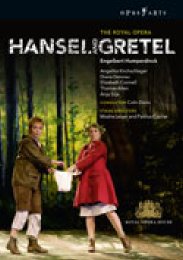
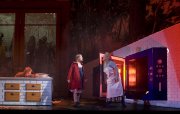
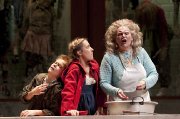
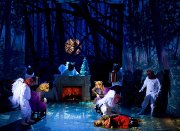
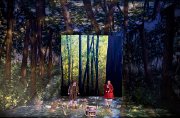
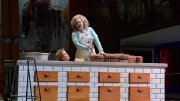
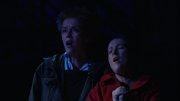

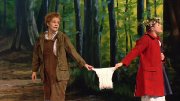




































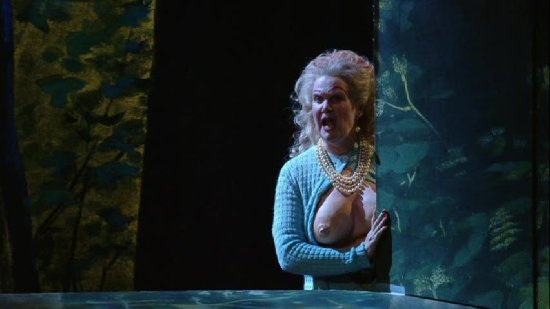
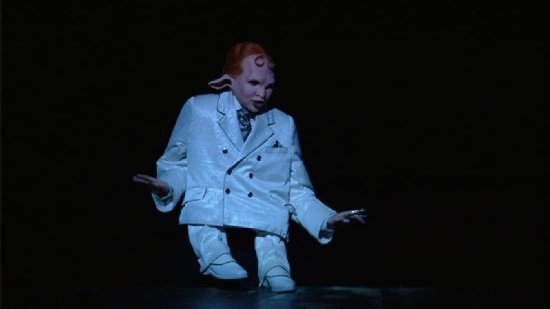


Your Opinions and Comments
Be the first to post a comment!